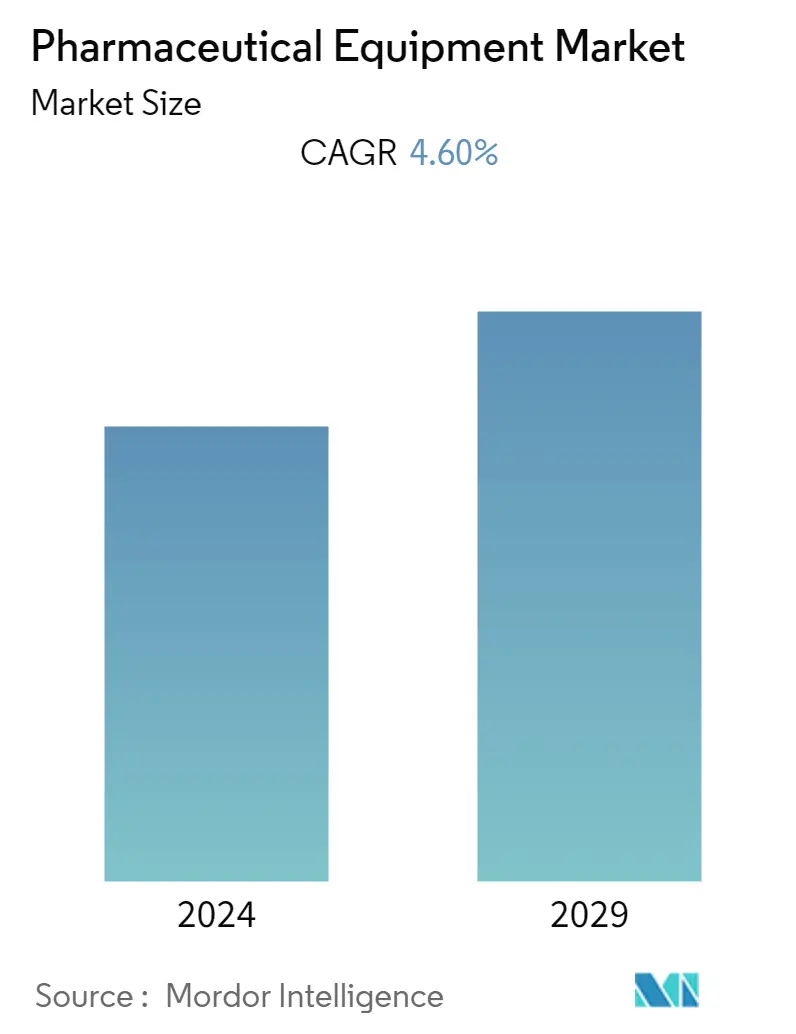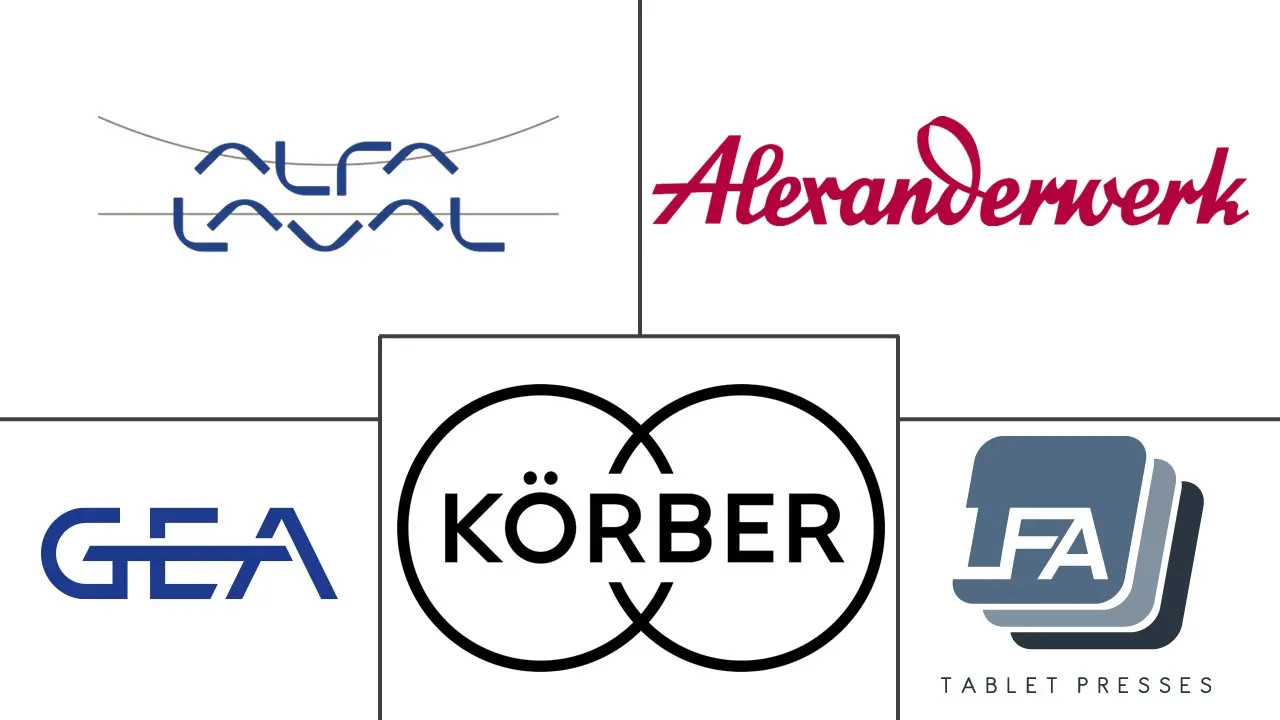Market Size of Pharmaceutical Equipment Industry

| Study Period | 2019 - 2029 |
| Base Year For Estimation | 2023 |
| CAGR | 4.60 % |
| Fastest Growing Market | Asia-Pacific |
| Largest Market | North America |
| Market Concentration | Medium |
Major Players
*Disclaimer: Major Players sorted in no particular order |
Pharmaceutical Equipment Market Analysis
The pharmaceutical equipment market is expected to grow at a CAGR of 4.6% over the forecast period.
Due to limitations on medicine production in biotech and pharmaceutical manufacturing facilities, trade restrictions, and a shortage of raw materials, the COVID-19 pandemic had a negative influence on the market in its earliest stages. However, the market recovered in the second phase of the pandemic thanks to the use of pharmaceutical machinery for medications connected to COVID-19 and the initiatives of important market participants. For instance, in May 2022, an article published in the National Library of Medicine stated that lipid nanoparticle (LNP)-formulated nucleoside-modified mRNA vaccines have proven to be very successful in the fight against the COVID-19 pandemic. Thus, the long-term storage of mRNA-LNP vaccines with lyophilization provides long-term stability for a lipid nanoparticle-formulated, nucleoside-modified mRNA vaccine. Hence, such advantages are expected to increase the market growth. Furthermore, initiatives such as in June 2022, Pfizer announced its commitment to United States manufacturing with a USD 120 million investment at its Kalamazoo, Michigan, facility, enabling United States-based production in support of its COVID-19 oral treatment, PAXLOVID (nirmatrelvir tablets and ritonavir tablets). Thus, such initiatives significantly impacted the market during the COVID-19 pandemic.
Factors such as high growth in the pharmaceutical and biopharmaceutical industry and technological developments are expected to increase market growth. For instance, in March 2022, Japan launched a new research and development center, for USD 1.6 billion, to support vaccine and drug projects as a part of a larger scheme to tackle infectious diseases. The establishment of an R&D facility for innovative partnerships and budget management will be under Supervisory Control And Data Acquisition (SCADA). Similarly, in December 2021, the Board of Global Alliance for Vaccine and Immunization (Gavi) approved an investment to support the malaria vaccine introduction, procurement, and delivery for Gavi-eligible countries in sub-Saharan Africa in 2022-2025. An initial investment of USD 155.7 million for 2022-2025 will initiate the implementation of this additional tool in the combat against malaria. Thus, such investments by the governments are expected to increase the adoption of pharmaceutical equipment which is expected to increase market growth over the forecast period.
Furthermore, investments by pharmaceutical companies in its production are another factor driving the market growth. For instance, in November 2021, Sartorius invested USD 300 million to launch cell culture media production and assemble sterile systems for efficient and flexible manufacturing of biopharmaceuticals in South Korea. Thus, such initiatives are expected to increase market growth over the forecast period. Similarly, a rise in technological developments based on agreements between industry players is expected to drive market growth. For instance, in July 2021, Huhtamaki and Syntegon agreed to create a paper-based tablet packaging solution for the pharmaceutical and healthcare industries. However, the high cost of equipment is expected to hinder market growth.
Pharmaceutical Equipment Industry Segmentation
As per the scope, pharmaceutical equipment helps manufacturers in the production of drugs with desired qualities and properties. The Pharmaceutical Equipment Market is Segmented by Type (Weighing Equipment, Lyophilizer, Pharmaceutical Water Equipment, Granulating Equipment, Packaging Equipment, and Others), Formulation (Tablets, Capsules, Injectables, and Other Formulations), End User (Pharmaceutical Manufacturing Companies, Contract Manufacturing, and Others), and Geography (North America, Europe, Asia-Pacific, Middle East and Africa, and South America). The market report also covers the estimated market sizes and trends for 17 different countries across the major regions globally. The report offers the values (USD million) for the above segments.
| By Type | |
| Weighing Equipment | |
| Lyophilizer | |
| Pharmaceutical Water Equipment | |
| Granulating Equipment | |
| Packaging Equipment | |
| Others |
| By Formulation | |
| Tablets | |
| Capsules | |
| Injectables | |
| Other Formulations |
| By End User | |
| Pharmaceutical Manufacturing Companies | |
| Contract Manufacturing Companies | |
| Others |
| Geography | ||||||||
| ||||||||
| ||||||||
| ||||||||
| ||||||||
|
Pharmaceutical Equipment Market Size Summary
The pharmaceutical equipment market is poised for steady growth over the forecast period, driven by advancements in the pharmaceutical and biopharmaceutical sectors. The initial setbacks caused by the COVID-19 pandemic, such as trade restrictions and raw material shortages, were mitigated by the increased demand for pharmaceutical machinery to support COVID-19 related medications. Key industry players, through strategic investments and innovations, played a crucial role in the market's recovery. For instance, significant investments in manufacturing facilities and the development of advanced technologies, such as lyophilization for mRNA vaccines, have bolstered market expansion. Additionally, government initiatives and investments in research and development, particularly in regions like North America and Japan, are expected to further propel market growth by enhancing the adoption of pharmaceutical equipment.
The market's growth trajectory is also supported by the rising acceptance of biopharmaceutical manufacturing equipment and the increasing utilization of lyophilizers in drug manufacturing processes. Investments by pharmaceutical companies in production capabilities, coupled with technological collaborations, are driving the market forward. However, the high cost of equipment remains a challenge. The market is moderately consolidated, with major players like Alexanderwerk, ALFA LAVAL, and GEA Group dominating the landscape. Ongoing product launches and strategic expansions, such as those by Telstar and Fluid Air, are anticipated to contribute to the market's development. Overall, the pharmaceutical equipment market is expected to experience sustained growth, supported by technological advancements, strategic investments, and favorable government policies.
Pharmaceutical Equipment Market Size - Table of Contents
-
1. MARKET DYNAMICS
-
1.1 Market Overview
-
1.2 Market Drivers
-
1.2.1 High Growth in Pharmaceutical and Biopharmaceutical Industry
-
1.2.2 Technological Advancements
-
-
1.3 Market Restraints
-
1.3.1 High Cost of Equipment
-
-
1.4 Porter's Five Force Analysis
-
1.4.1 Threat of New Entrants
-
1.4.2 Bargaining Power of Buyers/Consumers
-
1.4.3 Bargaining Power of Suppliers
-
1.4.4 Threat of Substitute Products
-
1.4.5 Intensity of Competitive Rivalry
-
-
-
2. MARKET SEGMENTATION (Market Size by Value - USD million)
-
2.1 By Type
-
2.1.1 Weighing Equipment
-
2.1.2 Lyophilizer
-
2.1.3 Pharmaceutical Water Equipment
-
2.1.4 Granulating Equipment
-
2.1.5 Packaging Equipment
-
2.1.6 Others
-
-
2.2 By Formulation
-
2.2.1 Tablets
-
2.2.2 Capsules
-
2.2.3 Injectables
-
2.2.4 Other Formulations
-
-
2.3 By End User
-
2.3.1 Pharmaceutical Manufacturing Companies
-
2.3.2 Contract Manufacturing Companies
-
2.3.3 Others
-
-
2.4 Geography
-
2.4.1 North America
-
2.4.1.1 United States
-
2.4.1.2 Canada
-
2.4.1.3 Mexico
-
-
2.4.2 Europe
-
2.4.2.1 Germany
-
2.4.2.2 United Kingdom
-
2.4.2.3 France
-
2.4.2.4 Italy
-
2.4.2.5 Spain
-
2.4.2.6 Rest of Europe
-
-
2.4.3 Asia-Pacific
-
2.4.3.1 China
-
2.4.3.2 Japan
-
2.4.3.3 India
-
2.4.3.4 Australia
-
2.4.3.5 South Korea
-
2.4.3.6 Rest of Asia-Pacific
-
-
2.4.4 Middle East and Africa
-
2.4.4.1 GCC
-
2.4.4.2 South Africa
-
2.4.4.3 Rest of Middle East and Africa
-
-
2.4.5 South America
-
2.4.5.1 Brazil
-
2.4.5.2 Argentina
-
2.4.5.3 Rest of South America
-
-
-
Pharmaceutical Equipment Market Size FAQs
What is the current Pharmaceutical Equipment Market size?
The Pharmaceutical Equipment Market is projected to register a CAGR of 4.60% during the forecast period (2024-2029)
Who are the key players in Pharmaceutical Equipment Market?
Alexanderwerk, ALFA LAVAL, GEA Group, Korber AG and LFA Machines Oxford LTD are the major companies operating in the Pharmaceutical Equipment Market.

